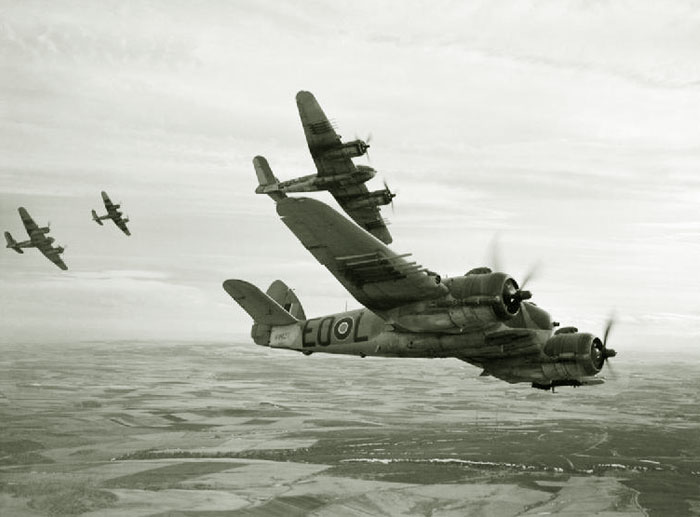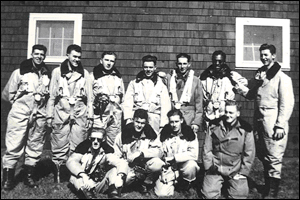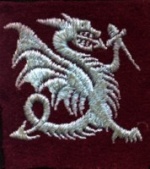Des afro canadiens dans la Royal Canadian Air Force
2 participants
Page 1 sur 1
 Des afro canadiens dans la Royal Canadian Air Force
Des afro canadiens dans la Royal Canadian Air Force
Bonsoir à tous !
Une fois n'est pas coutume , je vais vous présenter ici un sujet vraiment peu abordé , il s'agit des pilotes Afros canadiens ayant servi dans la Royal Air Force durant la Seconde Guerre Mondiale .
A la vue de la rareté du sujet des informations en Français n'existent tout simplement pas , que l'on m'excuse pour la barrière de la langue ( si quelqu'un se porte volontaire pour traduire je suis toute ouie ) .
Bonne lecture !


Gerry Bell, un natif d’ Hamilton, est considéré comme le premier aviateur noir du Canada.
Il a servi en Angleterre pendant la Deuxième Guerre mondiale et a continué sa carrière dans l’aviation jusqu’à sa mort .
Quand la guerre éclate en 1939, il est envoyé dans le Yorkshire, en Angleterre où pendant les quatre ans suivants il forme les pilotes du 6ème groupe de Bombardier
). Il a fini son service actif comme un artilleur aérien dans le 424ème escadron.
Gerry Bell, a native Hamiltonian, is regarded as Canada’s first black airman. He served in England during World War II and continued to be closely connected with aviation until his death.
Gerald “Gerry” Bell was born in Hamilton, Ontario in 1909. The future pilot’s first chosen career was medicine, but instead he served as a special RCMP constable while at the same time proving himself as a formidable athlete. He became a competitive sprinter, racing against the legendary Jesse Owens, and then a competitive amateur boxer, winning sixty-three of his sixty-seven bouts. While injuries prevented Bell from pursuing a professional career, hisathletic prowess enabled him to become a trainer at the Berlin Olympiad of 1936.
•
A chance encounter with a plane and its pilot at a nearby airstrip led to a lifelong passion for flying. Bell took clandestine flying lessons, for he was sure that his parents, proud of their aspiring doctor son, would not approve. However when the local daily paper, The Hamilton Spectator, ran a story about “the brown birdman” and “Canada’s only Negro aviator”, his cover was blown, his passion revealed and his career in medicine permanently sidelined. A few years after attaining his pilot’s license, Bell joined the still fledgling RCAF, only to leave not long afterwards during a period of financial cut backs. When he returned from the Olympiad in Berlin, Bell rejoined the Air Force, working with the 119th Bomber Reserve in his hometown of Hamilton. When the war broke out in 1939, Bell relocated to Yorkshire, England where for the next four years he trained the pilots of the 6th Bomber group. He ended his active duty as an air gunner in the 424th squadron. Bell's service was exceptional for the time. For My County: Black Canadians on the Field of Honour (p. 37) notes that blacks were denied enrollment in the RCAF. The book's authors seem unaware of Bell's existence and indicate that only one black airman is known to have served -- Flying Office Alan Bundy who joined the RCAF in 1943.
•
Following the war, Bell worked at bases across Canada before finally leaving the service in 1961. However, he could not leave his love of aircraft, and it wasn’t long before he began a new career as a military quality control officer, working first for de Haviland in Downsview, Ontario and then later at Spar Aerospace. At the age of sixty-five, Bell retired from his full-time day job, but even this decision was influenced by his love of aeronautics, as he chose to spend his retirement in Trenton, Ontario, the location of one of Canada’s largest and most active military airports, where many of his old friends in RCAF had also settled. Gerry Bell died on 17 January 1989 at the age of seventy-nine; he was buried not far from the airport and the world that dominated his life.
During his final years Bell’s lifetime of accumulated knowledge and experience was called into service one last time when he became involved in the restoration of the Avro Lancaster bomber. While 7,300 of these durable airships were originally produced in Britain and Canada during the war, only two still fly. One of them, helped back into the air by the old flyboy, Gerry Bell, has a permanent home at Canadian Warplane Heritage Museum in Bell’s hometown of Hamilton, Ontario. It remains one of the more tangible pieces of Bell’s important legacy to Canadian aviation.
Further resources:
McLaughlin, Dennis, and Leslie McLaughlin. For My Country Black Canadians on the Field of Honour (Canada: Ministry of National Defence, 2004)
Canadian Warplane Heritage Museum





http://www.vintagewings.ca/VintageNews/Stories/tabid/116/articleType/ArticleView/articleId/342/language/en-CA/Black-Buffalo.aspx

The man who broke this important colour barrier, Allan Selwyn Bundy, was born in 1920, in Dartmouth, Nova Scotia across the harbour from Halifax, where much of Canada's black population resided in the early part of the twentieth century. Bundy's father, William Henry Bundy served with No. 2 Construction Battalion during the First World War, a time when blacks were only allowed to serve in service, transport or manual labour units. Allan Bundy had three siblings; two brothers named Carl and Milton as well as a sister, Lillian. The family had a strong interest in aviation, as, in addition to Allan's service in the RCAF, Carl joined the Air Force in 1943, while youngest brother Milton, too young to serve in the war, was a member of No 18 Royal Canadian Air Cadet Squadron in Dartmouth.
Two photographs of Bundy from his Second World War service. On the left a photo of him in uniform with his new pilot brevet. On the right, a civilian photo of him taken for future need for escape documents. Hiding anonymously in a crowd behind German lines, should he need to evade capture would have been far more difficult for a man of colour in Nazi-held territory. One thing for sure, he was a better dresser than most pilots of the day. Photos via Jim Bates
Bundy and his brothers were champion track and field athletes in high school. Also an excellent and hard working student, Allan was awarded an I.O.D.E. (Imperial Order of the Daughters of the Empire) Scholarship to attend Dalhousie University, where he studied chemistry and continued to excel in sports. A 1943 article in the Toronto Star about him and his new status as Canada's first black military pilot states that he expected to become a doctor, though he goes on to say in the same article that if things go well with flying “I’ll give up the idea of becoming a doctor.”
Like many Canadian men during the Second World War, he wanted to serve and fight for his country. However, upon visiting an Air Force recruiting office in Halifax, his white friend “Soupy” Campbell, who had accompanied him, was accepted into the RCAF, while he was rejected without a a satisfactory explanation. Though he felt it as a personal racist initiative by the recruiter, and though the Halifax Recruiting Centre was known to be a place where blacks were turned away if they wished to join the RCAF or other services, it was a more insidious service-wide racist policy of the RCAF at the time to deny blacks service as air crew. Prior to March 31st of 1942, the RCAF had a policy of not allowing visible minorities to enlist as aircrew or even support-related trades for aircraft, such as airframe tech, aero-engine mechanic. They were only allowed to enlist in general duty trades such as cook, driver, clerk or labourer. At his first attempt to enlist, Bundy could have been accepted for General Duty, but was not denied a pilot or air crew spot because the recruiting officer decided he would not accept him, it was because the policy did not allow it.
About a year later, Bundy ignored an army conscription notice, which resulted in a visit from an RCMP officer. Bundy related in a 1997 Toronto Star article that, “I told him that I had gone to join the air force in 1939 and if the bullet that kills me is not good enough for the air force, then it is not good enough for the army either - so take me away.” Apparently this was enough for the Mountie, who did not arrest him. Even after the policy change that allowed blacks to enlist as true airmen, some recruiting officers across Canada made it hard for visible minorities to enlist. So when Bundy was finally accepted, it was because the policy had changed and the recruiting officer was doing his job properly.
After enlistment, he was put on leave for a couple of weeks as there were no training billets available immediately. In July of 1942, he was assigned to No. 5 Manning Depot in Lachine, Quebec for induction into the RCAF. After Manning Depot, he was assigned to pilot training at No. 9 Elementary Flying Training School at St. Catharines, Ontario where he soloed on the Tiger Moth. From his EFTS, he graduated to training on more powerful Harvards at No. 14 Service Flying Training School at Aylmer, Ontario in the heart of farming country. He received his wings and his commission as a Pilot Officer on September 3rd, 1943. Bundy must have been an excellent student and pilot, for only the top graduates on any course were awarded a commission. Considering the general attitude toward “negroes” in general even in Canada, his skill level must have been exceptional for him to be granted a commission right out of the gate.
As a newly winged and commissioned officer in the Royal Canadian Air Force, being black and fit, Bundy must have cut a striking figure in a blue uniform on the streets of nearby Toronto. He was then posted to 1 General Reconnaissance School in Summerside for further training. Here, pilots trained for nine weeks and navigators for four weeks in the art of operating long distances over open water and along coastal areas. The first students flew in the twin-engine Avro Anson Mark I, which were gradually replaced by the Mark V. Over 6000 airmen trained at the No. 1 GRS during the war. Upon graduation most were assigned to Coastal Command, which operated nearly every type of aircraft that engaged in anti-submarine warfare. Bundy, like most graduates of 1 GRS, was indeed destined for coastal duties - but in Europe. Following Summerside, he was posted overseas on December 11th, 1943.
"On arrival in Great Britain he reported to 3 Personnel Reception Centre at Bournemouth. From here, was sent to the Advanced Flying Unit (Pilot) and on from there to a Beaufighter Operational Training Unit; most likely 132 OTU given his eventual posting. Equipped with Beauforts and Beaufighters at the time, 132 OTU was tasked with training long range fighter and strike aircrew. In July 1943 it extended its training to complete crews and added torpedo and dive bomber training to its tasking. Viewing records, Mathias Joost states “He appears to have been promoted to Flying Officer on August 5th, 1944, but I cannot say with certainty what month as the record is quite poor”. For Bundy to be promoted at OTU before arriving at his squadron speaks volumes about the man and his abilities, as well as speaking volumes about the man who promoted him.
It would appear that strike crews – pilots and navigators – teamed up at the Beaufighter OTU before their final squadron assignment. Upon completing type conversion training and role specialization, Bundy was informed that none of the white navigators wanted to fly with him. This was a problem since the next phase in the syllabus at strike OTUs of the period was to pair up pilots and navigators as complete crews before shipping them off to operational squadrons. That left Bundy with no option but to transfer to a fighter squadron. However, during the pendency of the transfer, Flight Sergeant Elwood “Lefty” Wright agreed to be his navigator.
Beaufighters were truly two-man aircraft with the the pilot and navigator acting as a team. Flight Sergeant Elwood Cecil Wright (RCAF service no. R70344) enlisted at Galt, Ontario on April 20th, 1940 and was selected fro training as a wireless operator/airgunner. After getting his WAG brevet, he was selected as an instructor in the BCATP until his application for navigator was accepted. He then began training at No. 5 Air Observer School (AOS) in Winnipeg on May 10th, 1943. He was sent overseas on October 29th, 1943, on completion of his training. When he met up with Bundy he was a Flight Sergeant but was commissioned as a Pilot Officer on October 14th, 1944 and subsequently promoted to Flying Officer on April 14th, 1945.
Flying Officer Allan Bundy and Flight Sergeant Elwood Cecil Wright arrived, together with one other crew from their OTU, at 404 Squadron on September 27th 1944. They were declared operationally ready on October 8th and flew their first op on October 15th, against shipping near Kristiansand. On the October 15th op, Bundy and Wright participated with the squadron in the sinking of two enemy ships in Norway. This was the first of either 42 or 43 operations (sources vary) that Bundy and Wright flew as part of 404 Squadron in Beaufighters, and later Mosquitoes, from Banff and Dallachy, Scotland. On December 7, 1944 Bundy and Wright, flying Beaufighter NE800 “EE-N”, were part of a strike on Norway which was bounced by 25 German Fw-190 and Bf-109s. Their Mustang escort was able to deter the attackers, but the strike was aborted, and all members of 404 Squadron returned home, with only one navigator receiving minor wounds.



Lincoln Alexander


Un petit hommage personnel à ces pilotes en tenue Royal Canadian Air Force :



A visiter :
http://pw20c.mcmaster.ca/case-study/canada-s-first-black-airman-gerry-bell
http://www.vintagewings.ca/VintageNews/Stories/tabid/116/articleType/ArticleView/articleId/342/language/en-CA/Black-Buffalo.aspx
http://www.archives.gov.on.ca/en/explore/online/alexander/index.aspx
Une fois n'est pas coutume , je vais vous présenter ici un sujet vraiment peu abordé , il s'agit des pilotes Afros canadiens ayant servi dans la Royal Air Force durant la Seconde Guerre Mondiale .
A la vue de la rareté du sujet des informations en Français n'existent tout simplement pas , que l'on m'excuse pour la barrière de la langue ( si quelqu'un se porte volontaire pour traduire je suis toute ouie ) .
Bonne lecture !


Gerry Bell, un natif d’ Hamilton, est considéré comme le premier aviateur noir du Canada.
Il a servi en Angleterre pendant la Deuxième Guerre mondiale et a continué sa carrière dans l’aviation jusqu’à sa mort .
Quand la guerre éclate en 1939, il est envoyé dans le Yorkshire, en Angleterre où pendant les quatre ans suivants il forme les pilotes du 6ème groupe de Bombardier
). Il a fini son service actif comme un artilleur aérien dans le 424ème escadron.
Gerry Bell, a native Hamiltonian, is regarded as Canada’s first black airman. He served in England during World War II and continued to be closely connected with aviation until his death.
Gerald “Gerry” Bell was born in Hamilton, Ontario in 1909. The future pilot’s first chosen career was medicine, but instead he served as a special RCMP constable while at the same time proving himself as a formidable athlete. He became a competitive sprinter, racing against the legendary Jesse Owens, and then a competitive amateur boxer, winning sixty-three of his sixty-seven bouts. While injuries prevented Bell from pursuing a professional career, hisathletic prowess enabled him to become a trainer at the Berlin Olympiad of 1936.
•
A chance encounter with a plane and its pilot at a nearby airstrip led to a lifelong passion for flying. Bell took clandestine flying lessons, for he was sure that his parents, proud of their aspiring doctor son, would not approve. However when the local daily paper, The Hamilton Spectator, ran a story about “the brown birdman” and “Canada’s only Negro aviator”, his cover was blown, his passion revealed and his career in medicine permanently sidelined. A few years after attaining his pilot’s license, Bell joined the still fledgling RCAF, only to leave not long afterwards during a period of financial cut backs. When he returned from the Olympiad in Berlin, Bell rejoined the Air Force, working with the 119th Bomber Reserve in his hometown of Hamilton. When the war broke out in 1939, Bell relocated to Yorkshire, England where for the next four years he trained the pilots of the 6th Bomber group. He ended his active duty as an air gunner in the 424th squadron. Bell's service was exceptional for the time. For My County: Black Canadians on the Field of Honour (p. 37) notes that blacks were denied enrollment in the RCAF. The book's authors seem unaware of Bell's existence and indicate that only one black airman is known to have served -- Flying Office Alan Bundy who joined the RCAF in 1943.
•
Following the war, Bell worked at bases across Canada before finally leaving the service in 1961. However, he could not leave his love of aircraft, and it wasn’t long before he began a new career as a military quality control officer, working first for de Haviland in Downsview, Ontario and then later at Spar Aerospace. At the age of sixty-five, Bell retired from his full-time day job, but even this decision was influenced by his love of aeronautics, as he chose to spend his retirement in Trenton, Ontario, the location of one of Canada’s largest and most active military airports, where many of his old friends in RCAF had also settled. Gerry Bell died on 17 January 1989 at the age of seventy-nine; he was buried not far from the airport and the world that dominated his life.
During his final years Bell’s lifetime of accumulated knowledge and experience was called into service one last time when he became involved in the restoration of the Avro Lancaster bomber. While 7,300 of these durable airships were originally produced in Britain and Canada during the war, only two still fly. One of them, helped back into the air by the old flyboy, Gerry Bell, has a permanent home at Canadian Warplane Heritage Museum in Bell’s hometown of Hamilton, Ontario. It remains one of the more tangible pieces of Bell’s important legacy to Canadian aviation.
Further resources:
McLaughlin, Dennis, and Leslie McLaughlin. For My Country Black Canadians on the Field of Honour (Canada: Ministry of National Defence, 2004)
Canadian Warplane Heritage Museum





http://www.vintagewings.ca/VintageNews/Stories/tabid/116/articleType/ArticleView/articleId/342/language/en-CA/Black-Buffalo.aspx

The man who broke this important colour barrier, Allan Selwyn Bundy, was born in 1920, in Dartmouth, Nova Scotia across the harbour from Halifax, where much of Canada's black population resided in the early part of the twentieth century. Bundy's father, William Henry Bundy served with No. 2 Construction Battalion during the First World War, a time when blacks were only allowed to serve in service, transport or manual labour units. Allan Bundy had three siblings; two brothers named Carl and Milton as well as a sister, Lillian. The family had a strong interest in aviation, as, in addition to Allan's service in the RCAF, Carl joined the Air Force in 1943, while youngest brother Milton, too young to serve in the war, was a member of No 18 Royal Canadian Air Cadet Squadron in Dartmouth.
Two photographs of Bundy from his Second World War service. On the left a photo of him in uniform with his new pilot brevet. On the right, a civilian photo of him taken for future need for escape documents. Hiding anonymously in a crowd behind German lines, should he need to evade capture would have been far more difficult for a man of colour in Nazi-held territory. One thing for sure, he was a better dresser than most pilots of the day. Photos via Jim Bates
Bundy and his brothers were champion track and field athletes in high school. Also an excellent and hard working student, Allan was awarded an I.O.D.E. (Imperial Order of the Daughters of the Empire) Scholarship to attend Dalhousie University, where he studied chemistry and continued to excel in sports. A 1943 article in the Toronto Star about him and his new status as Canada's first black military pilot states that he expected to become a doctor, though he goes on to say in the same article that if things go well with flying “I’ll give up the idea of becoming a doctor.”
Like many Canadian men during the Second World War, he wanted to serve and fight for his country. However, upon visiting an Air Force recruiting office in Halifax, his white friend “Soupy” Campbell, who had accompanied him, was accepted into the RCAF, while he was rejected without a a satisfactory explanation. Though he felt it as a personal racist initiative by the recruiter, and though the Halifax Recruiting Centre was known to be a place where blacks were turned away if they wished to join the RCAF or other services, it was a more insidious service-wide racist policy of the RCAF at the time to deny blacks service as air crew. Prior to March 31st of 1942, the RCAF had a policy of not allowing visible minorities to enlist as aircrew or even support-related trades for aircraft, such as airframe tech, aero-engine mechanic. They were only allowed to enlist in general duty trades such as cook, driver, clerk or labourer. At his first attempt to enlist, Bundy could have been accepted for General Duty, but was not denied a pilot or air crew spot because the recruiting officer decided he would not accept him, it was because the policy did not allow it.
About a year later, Bundy ignored an army conscription notice, which resulted in a visit from an RCMP officer. Bundy related in a 1997 Toronto Star article that, “I told him that I had gone to join the air force in 1939 and if the bullet that kills me is not good enough for the air force, then it is not good enough for the army either - so take me away.” Apparently this was enough for the Mountie, who did not arrest him. Even after the policy change that allowed blacks to enlist as true airmen, some recruiting officers across Canada made it hard for visible minorities to enlist. So when Bundy was finally accepted, it was because the policy had changed and the recruiting officer was doing his job properly.
After enlistment, he was put on leave for a couple of weeks as there were no training billets available immediately. In July of 1942, he was assigned to No. 5 Manning Depot in Lachine, Quebec for induction into the RCAF. After Manning Depot, he was assigned to pilot training at No. 9 Elementary Flying Training School at St. Catharines, Ontario where he soloed on the Tiger Moth. From his EFTS, he graduated to training on more powerful Harvards at No. 14 Service Flying Training School at Aylmer, Ontario in the heart of farming country. He received his wings and his commission as a Pilot Officer on September 3rd, 1943. Bundy must have been an excellent student and pilot, for only the top graduates on any course were awarded a commission. Considering the general attitude toward “negroes” in general even in Canada, his skill level must have been exceptional for him to be granted a commission right out of the gate.
As a newly winged and commissioned officer in the Royal Canadian Air Force, being black and fit, Bundy must have cut a striking figure in a blue uniform on the streets of nearby Toronto. He was then posted to 1 General Reconnaissance School in Summerside for further training. Here, pilots trained for nine weeks and navigators for four weeks in the art of operating long distances over open water and along coastal areas. The first students flew in the twin-engine Avro Anson Mark I, which were gradually replaced by the Mark V. Over 6000 airmen trained at the No. 1 GRS during the war. Upon graduation most were assigned to Coastal Command, which operated nearly every type of aircraft that engaged in anti-submarine warfare. Bundy, like most graduates of 1 GRS, was indeed destined for coastal duties - but in Europe. Following Summerside, he was posted overseas on December 11th, 1943.
"On arrival in Great Britain he reported to 3 Personnel Reception Centre at Bournemouth. From here, was sent to the Advanced Flying Unit (Pilot) and on from there to a Beaufighter Operational Training Unit; most likely 132 OTU given his eventual posting. Equipped with Beauforts and Beaufighters at the time, 132 OTU was tasked with training long range fighter and strike aircrew. In July 1943 it extended its training to complete crews and added torpedo and dive bomber training to its tasking. Viewing records, Mathias Joost states “He appears to have been promoted to Flying Officer on August 5th, 1944, but I cannot say with certainty what month as the record is quite poor”. For Bundy to be promoted at OTU before arriving at his squadron speaks volumes about the man and his abilities, as well as speaking volumes about the man who promoted him.
It would appear that strike crews – pilots and navigators – teamed up at the Beaufighter OTU before their final squadron assignment. Upon completing type conversion training and role specialization, Bundy was informed that none of the white navigators wanted to fly with him. This was a problem since the next phase in the syllabus at strike OTUs of the period was to pair up pilots and navigators as complete crews before shipping them off to operational squadrons. That left Bundy with no option but to transfer to a fighter squadron. However, during the pendency of the transfer, Flight Sergeant Elwood “Lefty” Wright agreed to be his navigator.
Beaufighters were truly two-man aircraft with the the pilot and navigator acting as a team. Flight Sergeant Elwood Cecil Wright (RCAF service no. R70344) enlisted at Galt, Ontario on April 20th, 1940 and was selected fro training as a wireless operator/airgunner. After getting his WAG brevet, he was selected as an instructor in the BCATP until his application for navigator was accepted. He then began training at No. 5 Air Observer School (AOS) in Winnipeg on May 10th, 1943. He was sent overseas on October 29th, 1943, on completion of his training. When he met up with Bundy he was a Flight Sergeant but was commissioned as a Pilot Officer on October 14th, 1944 and subsequently promoted to Flying Officer on April 14th, 1945.
Flying Officer Allan Bundy and Flight Sergeant Elwood Cecil Wright arrived, together with one other crew from their OTU, at 404 Squadron on September 27th 1944. They were declared operationally ready on October 8th and flew their first op on October 15th, against shipping near Kristiansand. On the October 15th op, Bundy and Wright participated with the squadron in the sinking of two enemy ships in Norway. This was the first of either 42 or 43 operations (sources vary) that Bundy and Wright flew as part of 404 Squadron in Beaufighters, and later Mosquitoes, from Banff and Dallachy, Scotland. On December 7, 1944 Bundy and Wright, flying Beaufighter NE800 “EE-N”, were part of a strike on Norway which was bounced by 25 German Fw-190 and Bf-109s. Their Mustang escort was able to deter the attackers, but the strike was aborted, and all members of 404 Squadron returned home, with only one navigator receiving minor wounds.



Lincoln Alexander

Un petit hommage personnel à ces pilotes en tenue Royal Canadian Air Force :



A visiter :
http://pw20c.mcmaster.ca/case-study/canada-s-first-black-airman-gerry-bell
http://www.vintagewings.ca/VintageNews/Stories/tabid/116/articleType/ArticleView/articleId/342/language/en-CA/Black-Buffalo.aspx
http://www.archives.gov.on.ca/en/explore/online/alexander/index.aspx
 Re: Des afro canadiens dans la Royal Canadian Air Force
Re: Des afro canadiens dans la Royal Canadian Air Force
Sacré carrière pour Bell et Bundy, cela n'a pas dû être évident pour eux , comme cette histoire de navigateurs, refusant de voler avec un pilote noir .Merci, pour ce récit inédit . 
Amicalement,
le ronin.

Amicalement,
le ronin.
_________________
....La véritable personnalité d'un homme ne se dévoile qu'au feu, tout le reste n'est que littérature.....
Semper fidelis .

le ronin- Police militaire (Modérateur)

- Nombre de messages : 3529
Age : 72
Localisation : Dans l'Hérault, cong!
Date d'inscription : 25/06/2008
 Sujets similaires
Sujets similaires» Les canadiens dans le pacifique?
» Le rôle des canadiens dans la reconquête des Aléoutiennes.
» Canadian Intelligence Corps (C INT C)
» Alsaciens & Lorrains engagés de force dans l'armée allemande
» Afro-américaines ont débarqué en Normandie le jour J?
» Le rôle des canadiens dans la reconquête des Aléoutiennes.
» Canadian Intelligence Corps (C INT C)
» Alsaciens & Lorrains engagés de force dans l'armée allemande
» Afro-américaines ont débarqué en Normandie le jour J?
Page 1 sur 1
Permission de ce forum:
Vous ne pouvez pas répondre aux sujets dans ce forum